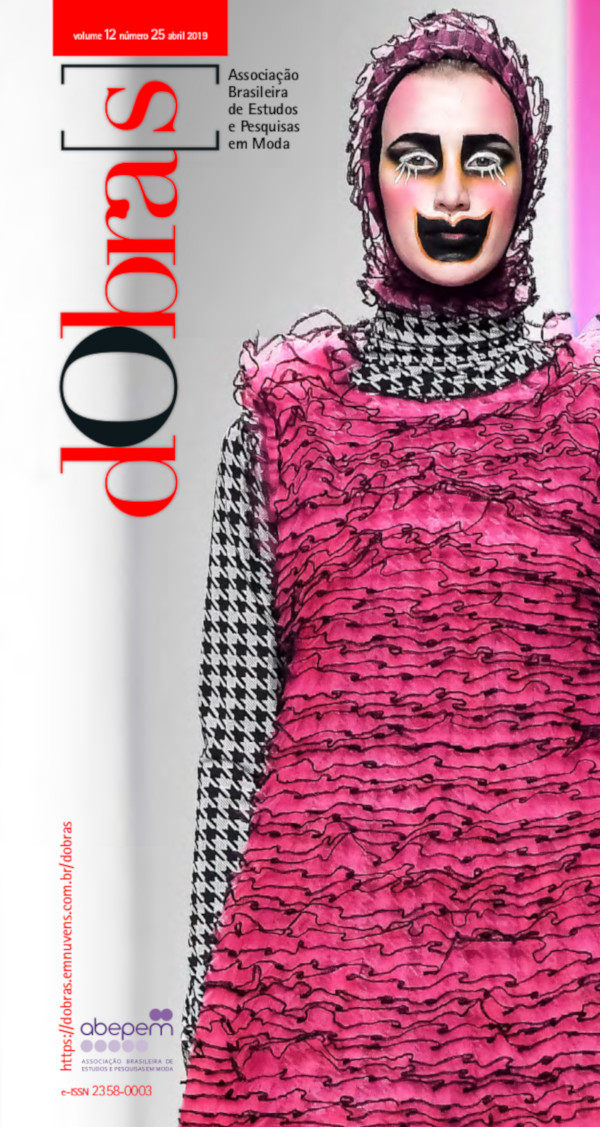Women in the fight for emancipation: new clothing and new behaviors through the lenses of the Rio de Janeiro press – 1900-1914
DOI:
https://doi.org/10.26563/dobras.v11i25.855Keywords:
clothing, female subculture, press, Rio de Janeiro.Abstract
This text presents a case study which focuses on how the predominantly male press in Rio de Janeiro used to present the new female behaviors associated to new dressing styles adopted by Carioca female subcultures. These were comprised of young women who were starting to have access to education and to the labor market in Rio de Janeiro at the beginning of the 20th century. As these youngsters integrated into the male dominated world, they began to wear new outfits that progressively included items from the male wardrobe. Thus, these clothing styles worked as a political instrument to mark a new social position for a new class of women.
Downloads
References
ARAÚJO, Rosa Maria B. A vocação do prazer: a cidade e a família no Rio de Janeiro republicano. 2. ed. Rio de Janeiro: Editora Rocco, 1993.
BARTKY, Sandra. Foucault, femininity, and the modernization of patriarchal power. In: DIAMOND, Irene; QUINBY, Lee (ed.). Feminism and Foucault: reflections on resistance. Boston: Northeastern University Press, 1988. p. 63-64.
BUTLER, Judith. Problemas de gênero: feminismo e subversão da identidade. Rio de Janeiro: Civilização Brasileira, 2015.
CRANE, Diana. A moda e seu papel social: classe, gênero e identidade das roupas. São Paulo: Senac, 2013.
ENTWISTLE, Joanne; WILSON, Elizabeth (ed.). Body dressing. Oxford/New York: Berg, 2001. DOI: https://doi.org/10.2752/9780857854032
FARIAS, Rita de Cássia Pereira. Uniforme de trabalho e emancipação feminina. In: BONADIO, Maria Claudia; MATTOS, Maria de Fátima da S. Costa G. História e cultura da moda. São Paulo: Estação das Letras e Cores, 2011. p. 60-84.
FOUCAULT, Michel. Vigiar e punir: nascimento da prisão. Petrópolis: Editora Vozes, 2014.
HUHNER, June E. Emancipação do sexo feminino: a luta pelos direitos da mulher no Brasil: 1850-1940. Florianópolis: Editora Mulheres, 2003.
JAGGAR, Alison. Feminist politics and human nature. Tottowa, NJ: Rowman and Allanheld, 1983.
LOURO, Guacira. Mulheres em sala de aula. In: DEL PRIORE, Mary; PINSKY, Carla Bassanezi (org.). História das Mulheres no Brasil. São Paulo: Ed Contexto, 1997. p. 443-482.
MCLAREN, Margaret A. Foucault, feminismo e subjetividade. São Paulo: Intermeios, 2016. Coleção Entregêneros.
MARQUES, Joviana Fernandes. Mulheres ilustradas: representações femininas nos Estados Unidos e no Brasil (1890-1945). 2016. Dissertação (Mestrado em Artes, Cultura e Linguagens) – Instituto de Artes e Design, Universidade Federal de Juiz de Fora, Juiz de Fora, 2016
MENDES, Valerie; LA HAYE, Amy de. A moda do século XX. Rio de Janeiro: Martins Fontes, 2009.
MILLER, Daniel. Trecos, troços e coisas: estudos antropológicos sobre a cultura material. Rio de Janeiro: Editora Zahar, 2013.
NEEDELL, Jeffrey D. Belle Époque tropical: sociedade e cultura de elite no Rio de Janeiro na virada do século. Tradução de Celso Nogueira. São Paulo: Companhia das Letras, 1993.
PEREIRA, Imaculada das Graças Maximiano. A toga e suas significações: dos primórdios à contemporaneidade. Monografia (Especialização em Moda) – Instituto de Artes e Design, Universidade Federal de Juiz de Fora, Juiz de Fora, 2010.
RAGO, Margareth. Do cabaré ao lar: a utopia da sociedade: 1890-1930. Rio de Janeiro: Paz e Terra, 1985.
THORNTON, Sarah. Club cultures: music, media and subcultural capital. Cambridge: Polity Press, 1995.
GANE, Nicholas. When We Have Never Been Human, What Is to Be Done?. Interview with Donna Haraway. Theory, Culture & Society, v. 23, n. 7–8, p. 135-158, Dec. 2006. doi:10.1177/0263276406069228 DOI: https://doi.org/10.1177/0263276406069228
WILLS, Paul. Common culture: symbolic work at play in the everyday cultures of the young. London: Open University Press, 1990.
WILSON, Elizabeth. Adorned In dreams: fashion and modernity. London/New York: I. B. Tauris, 2003.
Downloads
Published
How to Cite
Issue
Section
License
The copyrights of the works published in this journal belong to the author, and dObra[s] holds the rights of first publication. Due to their publication in this open access journal, any work here is free to use, with its own attributions, in educational and non-commercial applications.










